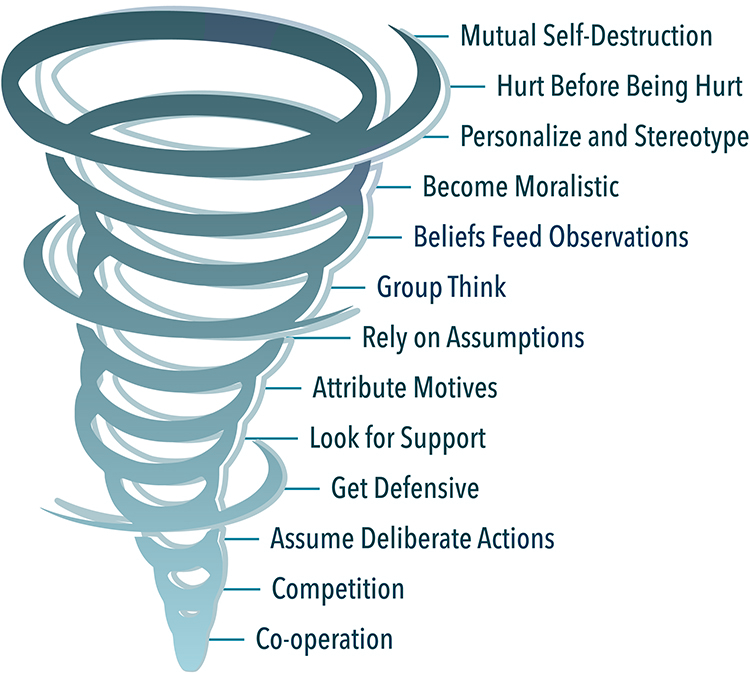2.1 The Conflict Process
In this Section:
The Conflict Process
The most commonly accepted model of the conflict process was developed by Kenneth Thomas (1976). This model, consists of four stages: (1) frustration, (2) conceptualization, (3) behavior, and (4) outcome.

Let’s review each stage in more detail.
Stage 1: Frustration
As we have seen, conflict situations originate when an individual or group feels frustration in the pursuit of important goals. This frustration may be caused by a wide variety of factors, including disagreement over performance goals, failure to get a promotion or pay raise, a fight over scarce economic resources, new rules or policies, and so forth. In fact, conflict can be traced to frustration over almost anything a group or individual cares about.
Stage 2: Conceptualization
In stage 2, the conceptualization stage of the model, parties to the conflict attempt to understand the nature of the problem, what they themselves want as a resolution, what they think their opponents want as a resolution, and various strategies they feel each side may employ in resolving the conflict. This stage is really the problem-solving and strategy phase. For instance, when management and union negotiate a labor contract, both sides attempt to decide what is most important and what can be bargained away in exchange for these priority needs.
Stage 3: Behavior
The third stage in Thomas’s model is actual behavior. As a result of the conceptualization process, parties to a conflict attempt to implement their resolution mode by competing or accommodating in the hope of resolving problems. A major task here is determining how best to proceed strategically. That is, what tactics will the party use to attempt to resolve the conflict? Thomas has identified five modes for conflict resolution: (1) competing, (2) collaborating, (3) compromising, (4) avoiding, and (5) accommodating. We will discuss these modes in further detail below.
Stage 4: Outcome
Finally, as a result of efforts to resolve the conflict, both sides determine the extent to which a satisfactory resolution or outcome has been achieved. Where one party to the conflict does not feel satisfied or feels only partially satisfied, the seeds of discontent are sown for a later conflict. One unresolved conflict episode can easily set the stage for a second episode. Managerial action aimed at achieving quick and satisfactory resolution is vital; failure to initiate such action leaves the possibility (more accurately, the probability) that new conflicts will soon emerge.
Conflict Escalation
Many academics and conflict resolution practitioners have observed predictable patterns in the way conflict escalates. Conflict is often discussed as though it is a separate entity, and in fact it is true that an escalating dispute may seem to take on a life of its own. Conflict will often escalate beyond reason unless a conscious effort is made to end it.
Figure 2.2 is called the conflict escalation tornado. It demonstrates how conflict can quickly escalate out of control. By observing and listening to individuals in dispute, it is often possible to determine where they are in the escalation process and anticipate what might occur next. In doing so, one can develop timely and appropriate approaches to halt the process.

Let’s Focus: Escalating Conflict Example
 The following is an example of an escalating conflict. Most people will recognize their own actions in the description. A conflict begins . . .
The following is an example of an escalating conflict. Most people will recognize their own actions in the description. A conflict begins . . .
- The parties become aware of the conflict but attempt to deal with it sensibly. Often, they will attribute the problem to “a misunderstanding” and indicate that “they can work it out.”
- The parties begin to slide from cooperation to competition. (“I’ll bend but only if they will first.”) They begin to view the conflict as resulting from deliberate action on the part of the other. (“They must have known this would happen.”) Positions begin to harden and defensiveness sets in, which creates adversarial encounters. Parties begin to take actions to strengthen their positions and look to others for support. (“Don’t you feel this is reasonable?” “Do you know what that idiot is doing to me?”)
- As communication deteriorates, parties rely more on assumptions about the other and attribute negative motives to them. (“I’ll bet they are going to . . . ,” “Those sorts of people would . . . ,” “Their thinking is so muddled, they must . . .”) Groupthink often takes over as each disputant seeks support from others. (“We have to appear strong and take a united front.”) Parties begin to look for more evidence of other problems—their beliefs feed their observations.
- Parties soon believe that cooperation cannot resolve the problem because of the actions of the other, and aggressive actions are planned. (“I’ve tried everything to get them to see reason.” “It’s time to get tough with them.” “I’m going to put a stop to this.”)
- Parties begin to feel righteous and blame the other for the whole problem. Generalizing and stereotyping begin. (“I know what those people are like. . . . We can’t let them get away with this.”) Parties begin to be judgemental and moralistic, and believe they are defending what is right. (“It’s the principle of the matter.” “What will people say if we give in to this?”)
- The conflict becomes more complicated but also more generalized and personalized. Severe confrontation is anticipated and, in fact, planned for, thus making it inevitable. The parties view this as acceptable as the other has, in their mind, clearly shown they are lacking in human qualities. (“He’s just a jerk; we’ll have to really hit him hard.”)
- All parties appears now to believe that the objective of the conflict is to hurt others more than they are being hurt. (“I’ll make you pay even if we both go down over this.”) The dispute is beyond rational analysis; causing damage to the other, even at your own expense, is the main focus. (“Whatever it takes . . .” “There is no turning back now.” “They won’t make a fool out of me.”)
- Finally, destruction of the other, even if it means self-destruction as well, is the driving force. (“If it takes everything I have, for the rest of my life . . .”)
Consider This: Risk for Workplace Violence
 An extreme escalation of conflict might include violence in the workplace. While violence can occur in any situation, below are some examples of roles and situations that make violence more likely to occur at work.
An extreme escalation of conflict might include violence in the workplace. While violence can occur in any situation, below are some examples of roles and situations that make violence more likely to occur at work.
Dealing With People
Jobs which involve dealing with other people increase the opportunities for conflict. Some examples include:
- Caring for others either emotionally or physically, such as at a long-term care home
- Interacting with frustrated customers, such as with retail sales.
- Supervising others, such as being a manager.
- Denying requests others make of you, such as with customer service.
Being in High-Risk Situations
Jobs which involve high-risk situations also can increase the probability of violence. Examples of high-risk situations include:
- Dealing with valuables or exchanging money, such as in banking.
- Handling weapons, such as in law enforcement or corrections.
- Working with drugs, alcohol, or those under the influence of them, such as bartending.
- Working nights or weekends, such as gas station attendants.
Sources: Adapted from information in LeBlanc, M. M., & Kelloway, E. K. (2002). Predictors and outcomes of workplace violence and aggression. Journal of Applied Psychology, 87, 444–453; National Institute for Occupational Safety and Health. (1997). Violence in the workplace. Retrieved November 12, 2008, from http://www.cdc.gov/niosh/violfs.html; National Institute for Occupational Safety and Health. (2006). Workplace prevention strategies and research needs. Retrieved November 12, 2008, from http://www.cdc.gov/niosh/docs/2006-144/.
Strategies for De-escalating Conflict
An appropriate level of risk must be taken by the individuals involved to de-escalate the conflict. Taking these risks can be scary as it requires people to be vulnerable and express emotions. Emotional intelligence plays an important role in the de-escalation of conflict. By taking risks to de-escalate conflict, whether the result is successful or unsuccessful, we can send a message of wanting to rebuild trust, respect, and effective communication. Risk taking can also provide an opportunity to make necessary change by learning and developing new behaviours and capacities to work effectively as individuals and as work units.
Typically, when conflict is not de-escalated and resolved appropriately, it results in more conflict in the relationship. The relationship continues in a state of heightened sensitivity to actions, and assumptions can be formed quickly. Actions that may previously have been viewed as innocent or acceptable may be perceived as threatening. Every unresolved conflict reduces the time it takes to get to the top of the tornado because of this heightened sensitivity. The following steps are suggestions for use at every stage of conflict escalation. The ability to harness fear and be vulnerable is a critical step for de-escalation.
Table 2.1 Steps to De-Escalate Conflict
| Step 1: Self Awareness |
| - Reflect on your own approach and the approach of others. |
| - Find people to you trust to discuss potential solutions. |
| - Think about who may challenge your perspective rather than who would agree with you |
| Step 2: Raising The Issue |
| - Decide to raise the issue with the other person(s) when it is important or affects you personally. |
| - Raise the issue at an appropriate time. |
| - Commit to a change in your own behaviour(s) that contribute to resolution. |
| - When raising the issue, use specific examples to limit confusion. Speaking from your perspective will reduce defensiveness. Use "I" language rather than "you." |
| Step 3: Follow Up |
| - Follow up with others and assess if a change has been made. |
| - Determine if a change is continuing to work. |
| - If the change is not working, decide what adjustments need to me made. |
| Step 4: When Change Is Not Implemented |
| - Raise the issue again if necessary. |
| - Use further problem solving by focusing on what each person need to create the necessary change and discuss any available actions. |
| - While problem solving,. compare the options presented with the necessary outcome (i.e., what is needed). |
| - If a resolution cannot be reached with others , determine what change(s) you can make that would bring some resolution to you personally. |
Table Source: The Dispute Resolution Office, Ministry of Justice (Government of Saskatchewan), designed by JVDW Designs, is licensed under a CC BY 4.0 International License. Reproduced from Leadership and Influencing Change In Nursing by Joan Wagner.
Adapted Works
“Conflict and Negotiations” in Organizational Behaviour by OpenStax is licensed under a Creative Commons Attribution 4.0 International License.
“Identifying and Understanding How to Manage Conflict” in Leadership and Influencing Change in Nursing by Joan Wagner is licensed under a Creative Commons Attribution 4.0 International License, except where otherwise noted.
References
Thomas, K. (1976). Conflict and conflict management. In M. D. Dunnette (Ed.), Handbook of industrial and organizational psychology (pp. 889-935). Rand McNally.

